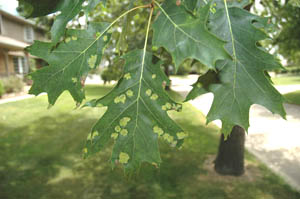Oak Leaf Blister
June 6, 2007
If you have been noticing some unsightly problems on oak leaves, the leaf tissue may be infected with Taphrina caerulescens. This pathogen is known to cause the disease known as oak leaf blister. There have been recent reports of this disease in northern Illinois. A cool, wet spring provides favorable conditions for this disease, and only isolated parts of the state experienced those conditions this year.
Oak leaf blister occurs worldwide. This disease has been reported on 10 oak species in the Midwest; however all oak species could be affected. Red oaks seem to be very susceptible, and white oaks have been reported to be more resistant. Still, damage is mostly aesthetic.
This pathogen infects only the leaf tissues. Symptoms of oak leaf blister begin as circular, raised spots on the upper surface of the leaf, as seen in the picture.

Later, these lesions will merge and become wrinkled, brown, and curled. Some defoliation may result due to heavy infestation, but leaf drop is usually not significant. The pathogen Taphrina carulescens can overwinter in bud scales and bark crevices.
The good news is there is no need to panic. This disease is not considered serious, and chemical control is not usually recommended or economically warranted. It is always a good practice to rake and destroy the infected, fallen leaves to help reduce the spread of disease. In addition, maintaining the health of trees by properly watering, pruning, and fertilizing helps to reduce the effect of this disease. If you are having problems with leaf curl and blisters and wish to use a fungicide control, you need to make a late-fall or winter fungicide application. Mark your calendar now as a reminder.
Fungicide options for homeowners are listed in the Home, Yard, and Garden Pest Guide. Fungicides available to commercial growers are listed in the Commercial Landscape and Turfgrass Pest Management Handbook. Both handbooks are available from https://PubsPlus.uiuc.edu/. For more on leaf curls and blisters, consult Report on Plant Disease, no. 805, "Peach Leaf Curl and Plum Pockets" (Adobe PDF), or no. 663, "Oak Leaf Blister" (Adobe PDF). Both are available in Illinois Extension offices or on the U of I Web site. (Stephanie Porter, Plant Clinic Diagnostician)
Author: Nancy Pataky
